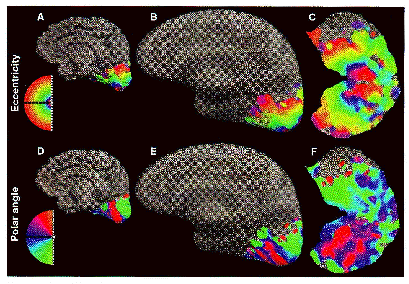Maps of Human
Visual Areas:
stimuli with iso-eccentricity and iso-polar angle
stimuli with iso-eccentricity and iso-polar angle
Original cortical surface
(A), the unfolded cortical surface (B), and the cut and flattened cortical
surface (C). Local eccentricity and polar angle were determined by considering the
phase of the response to a slowly dilating ring or a slowly rotating
hemifield at the dilation or rotation frequency.

Isoeccentricity (expanding rings): Color shows response phase. Red/purple = fovea.
Polar angle (rotating wedge): Red = lower vertical meridian.